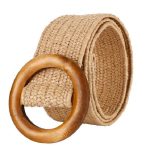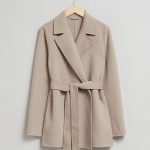Belts: they’re more than just functional accessories that hold up your pants. They’re a versatile tool that can elevate your style, accentuate your figure, and add a touch of personality to any outfit. But beyond the traditional waist-cinching role, belts can be used in various creative and unexpected ways. Let’s explore the diverse ways to use a belt, from mastering the basics to unlocking its full fashion potential.
The Foundation: Fastening a Belt Securely
Before we delve into styling tricks, let’s master the fundamental skill of fastening a belt securely.
-
Buckle Belts: The most common type of belt, featuring a prong and a series of holes.
- Thread the belt through the loops on your pants or skirt, ensuring the buckle is on the outside.
- Insert the prong through the appropriate hole, ensuring a snug but comfortable fit.
- Tuck the excess tail end neatly into a belt loop or let it hang loose for a more casual look.
-
D-Ring Belts: These belts feature two metal D-rings instead of a traditional buckle.
- Thread the belt through both D-rings, starting from the underside.
- Overlap the two ends of the belt and pull the tip through the second D-ring.
- Pull the belt tight to secure it and adjust the length as needed.
-
Tie Belts: Tie belts, often made from fabric or leather, offer a versatile and adjustable option.
- Wrap the belt around your waist, ensuring the two ends meet in the front.
- Tie a knot, such as a square knot or a bow, to secure the belt.
- Adjust the belt to your desired fit and style the knot as you like.
Choosing the Right Size
- Measure your waist: Measure your waist at the point where you intend to wear the belt.
- Add a few inches: Choose a belt size that’s a few inches larger than your waist measurement to allow for comfortable breathing room and adjustment.
Defining the Waist: Accentuating Your Figure
One of the primary functions of a belt is to define your waistline and create a more flattering silhouette.
-
High-Waisted Bottoms: Pair a belt with high-waisted pants, skirts, or shorts to accentuate your waist and create an hourglass figure.
-
Flowy Dresses: Cinch a belt over a loose-fitting or flowy dress to add shape and definition.
-
Oversized Tops: Use a belt to create a cinched waist and add structure to oversized tops or sweaters.
Belt Width Matters
-
Thin Belts: Thin belts are ideal for creating a subtle definition and complementing delicate or feminine outfits.
-
Medium-Width Belts: Medium-width belts offer a versatile option that works well with both casual and dressier looks.
-
Wide Belts: Wide belts make a bolder statement and can be used to create a dramatic cinched-in effect.

Adding Style and Personality: Beyond Functionality
Belts are not just about function; they can also be a stylish accessory that expresses your personality and complements your outfit.
Statement Buckles
A belt with a unique or eye-catching buckle can add a touch of flair and become a focal point of your ensemble.
Colorful or Patterned Belts
Opt for belts in bold colors or playful patterns to inject personality into your look.
Textured Belts
Braided leather belts, woven belts, or those with embossed details add a touch of texture and visual interest.
Chain Belts
Chain belts offer a modern and edgy alternative to traditional leather belts.
Accessorizing Tips
- Coordinate with Other Accessories: Choose a belt that complements your shoes, handbag, or other accessories.
- Consider the Occasion: Match the style of your belt to the occasion. A casual belt might not be appropriate for a formal event, while a dressy belt might feel out of place in a relaxed setting.
Belts are versatile accessories that offer both functionality and style. By mastering the art of tying a belt and exploring its various styling possibilities, you can elevate your outfits and express your individuality.
Remember, the key is to choose belts that fit well, complement your wardrobe, and make you feel confident and stylish. So, go ahead, embrace the power of the belt, and let it become an essential part of your fashion repertoire.
Belts for Different Occasions: Dressing Up or Down
Belts can adapt to various occasions, enhancing your overall look and adding a touch of polish or personality.
Casual Settings
- Jeans and a T-Shirt: A classic leather belt or a casual woven belt complements the laid-back vibe of jeans and a t-shirt.
- Shorts and a Polo: Opt for a canvas or braided belt with shorts and a polo shirt for a summery and preppy look.
- Dresses and Skirts: A thin belt can cinch the waist and add definition to flowy dresses or skirts.
Work or Formal Attire
- Dress Pants and a Button-Down Shirt: A classic leather belt in a neutral color like black or brown is a staple for professional attire.
- Suits: Choose a slim leather belt that matches the color of your shoes for a polished and cohesive look.
- Skirts and Blouses: A thin or medium-width belt can add a touch of elegance to a skirt and blouse combination.

Belts Beyond Fashion: Functional Applications
While belts are primarily associated with fashion, they also serve functional purposes beyond cinching your waist.
-
Tool Belts: For those engaged in trades or DIY projects, tool belts offer a convenient way to carry tools and essentials, keeping them within easy reach.
-
Utility Belts: Utility belts, often used in outdoor activities or tactical situations, provide a secure way to carry gear like flashlights, multi-tools, or first-aid kits.
-
Weightlifting Belts: Weightlifting belts provide support and stability during heavy lifting exercises, helping to prevent injuries and improve performance.
-
Maternity Belts: Maternity belts offer support and relief for pregnant women, helping to alleviate back pain and improve posture.
Choosing the Right Belt: Factors to Consider
When selecting belts, consider the following factors to ensure it meets your needs and complements your style.
-
Material: Choose a material that suits the occasion and your personal preferences. Leather is classic and durable, while fabric or woven belts offer a more casual vibe.
-
Width: The width of the belt should be proportionate to your body size and the size of your belt loops. Thin belts are generally more versatile, while wider belts make a bolder statement.
-
Buckle: The buckle style can dramatically impact the overall look of the belt. Choose a buckle that complements your outfit and personal style.
-
Color: Neutral colors like black, brown, and tan are versatile and easy to pair with various outfits. However, don’t be afraid to experiment with bolder colors or patterns to add a pop of personality.
Caring for Your Belts: Ensuring Longevity
Proper care and maintenance are essential for preserving the beauty and functionality of your belts.
-
Leather Belts: Clean leather belts with a damp cloth and mild soap or a specialized leather cleaner. Condition them periodically to keep the leather supple and prevent cracking.
-
Fabric Belts: Wash fabric belts according to the care label instructions. If handwashing, use a gentle detergent and lukewarm water.
-
Storage: Store your belts rolled up or hanging on belts rack to prevent creases and wrinkles. Avoid storing them in damp or humid environments.

Conclusion
Belts are versatile accessories that offer both fashion and function. From cinching your waist to adding a touch of personality or serving practical purposes, belts play a crucial role in completing your look and enhancing your everyday life.
By mastering the art of tying belts, exploring various styles and materials, and caring for your belts properly, you can ensure they remain stylish and functional companions for years to come.
Remember, the best way to use belts is with confidence and creativity. So, go ahead, experiment with different styles, and let your belts become an integral part of your fashion repertoire.


